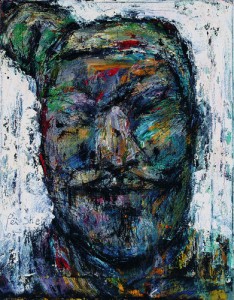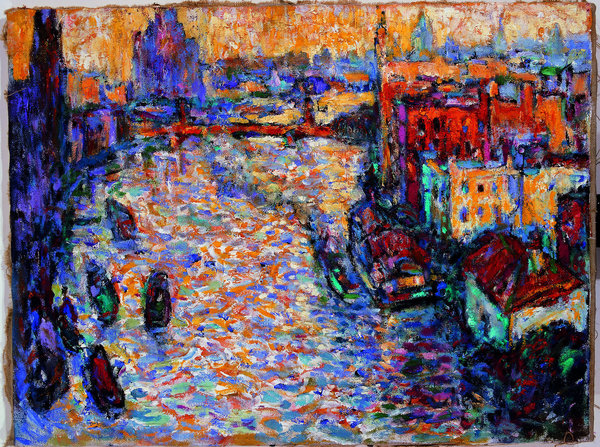What Puts Soul in a Masterpiece?
Recently, The Art Newspaper reported that Pei-Shen Qian had some of his paintings included in a group exhibition in a Shanghai gallery last spring. Scandal-following readers will recognize the name as that of a Chinese artist, once living in Queens, whose imitations of paintings by Pollock, de Kooning and other Abstract Expressionists were sold as real for millions of dollars by the New York gallery Knoedler & Company, now defunct.

Personal works by Pei-Shen Qian were shown at the BB Gallery in Shanghai in 2006 as part of a 25-year retrospective of his artistic career. Pictured is an example from that show. BB Gallery, Shnghai
In China, where he regularly returned for extended visits after moving to New York in 1981, Mr. Qian, 73, is known for his own paintings. He first emerged as an artist in the late 1970s, one of a group producing and exhibiting abstract work, which Cultural Revolution authorities deemed bourgeois and decadent. In 2006, he had a 25-year retrospective at the BB Gallery in Shanghai. Some of his works are posted on various websites. Naturally, you wonder, are Mr. Qian’s own paintings any good? Would I like to review them, my editor asked?
I can’t, in good conscience, review works I’m able to see only online. But I can say, provisionally, that I’m struck by the absence of any singular vision among his pieces. My laptop screen shows earnestly made, colorful landscapes and cityscapes that evoke early Post-Impressionist paintings by Matisse and André Derain. Some mixed-media works represent faceless women in a style that hybridizes classical Chinese painting and early-20th-century Cubism, made on what appear to be surfaces of patched-together burlap.
A picture of a horse including stenciled white letters spelling “This is not a horse” echoes Magritte’s painting of a pipe captioned “Ceci n’est pas une pipe” (“This is not a pipe”). Several paintings are of large, generalized heads rendered in a soupy, Expressionist manner.
Nostalgia seems to be the unifying mood of Mr. Qian’s paintings. That, alone, is remarkable, because the European works that evidently inspired him were revolutionary in their time. The kind of painting he emulates in his own work and the Abstract Expressionist paintings on which he has based his imitations both depended on originality and expressive authenticity, as opposed to academic tradition and technical polish. Yet Mr. Qian seems to be the opposite of original.
I suppose he works in styles he loves without worrying about whether they’re outmoded. Unless there’s something going on that can’t be seen in online images, it seems unlikely that Mr. Qian’s personal paintings will cause anything like the stir his imitations have.
That is disappointing but not surprising. I like the fantasy of the unjustly neglected genius who gets revenge on the art world by making expert-fooling works that mimic the style of famous painters. (Mr. Qian has not been charged with any crime related to the scandal.) But I think it more likely that the typical copyist will be relatively lacking in originality. Copyists need to be able to muffle their own creative selves, and if those creative selves are weak, all the better.
What they need in abundance are technical knowledge and skill. It’s not easy to make forgeries. However hard it was for Barnett Newman to produce one of his zip paintings, making a convincing fake Newman — reverse-engineering it, in effect, as well as making it look appropriately aged — surely will be more demanding technically, if not spiritually.
Mr. Qian’s creations, which were not copies of actual works but in the style of famous artists, intrigue me more than his personal work, but not for technical reasons. They raise interesting philosophical questions: Why should we value a painting known to be made by a certain esteemed artist more than a painting that is phony but is nevertheless practically indistinguishable from the authentic work? Why is a real Motherwell worth millions of dollars more than a fake one that looks just as good?
The dynamics of supply and demand are what make any artwork worth its price. Real things are worth more than fake ones simply because they are more rare.
Demand is more fluid and variable than supply because it’s influenced by vagaries of taste and fashion; it’s less rational. Demand is partly animated by some quasi-magical beliefs about art and artists, like the idea that there’s a sort of organic connection between artists and the things they make. The artist’s soul is somehow in the work, and because great artists are supposed to have great souls, there’s more soul in their creations than there is in mediocre efforts.
From there, it’s a short leap of faith to the belief that market valuation reflects soul value — not perfectly, but at least roughly and in the long term. The most expensive works have the most soul. That’s why, if you can afford it, you buy the real Motherwell. There’s no magic, no soul, in fake artworks, so they are worth less, if not completely worthless.
Mr. Qian told Bloomberg Businessweek that he thought he was being commissioned to make paintings for art lovers who could not afford the genuine works but were willing to buy imitations. I don’t know if such people really exist, but Mr. Qian seems to have thought they did. He didn’t imagine that there was anything ethically or legally wrong with what he was doing. He was a copyist but not a forger, if intention to deceive is part of the definition of a forger.
Mr. Qian told a reporter that he was shocked to learn what art dealers actually did with his simulations, for which they paid him a few thousand dollars per piece. He also said that he thought that it was impossible to make fakes that would be undetectable as such. Apparently, he didn’t even try: Signs of age and forged signatures, prosecutors say, were added by the man who ordered the paintings, the art dealer Jose Carlos Bergantiños Diaz.
The art market depends on the belief, expressed by Mr. Qian, that fakes can always be detected. Collective wisdom supposes that the forgery must, at some level, betray itself, and much connoisseurial scrutiny and forensic investigation goes into ensuring that as many deceptions as possible are ultimately exposed. Forgeries flooding the market unchecked would throw relations between supply and demand out of whack, causing economic chaos.
That’s what makes stories like that of Mr. Qian and the people he worked for so compelling. They are players in contemporary morality tales, myth-saturated chronicles about the upset and the restoration of order in the capitalist universe. It would make a more thrilling story if Mr. Qian turned out to be a great artist in his own right. Judging from what we can see online, however, that happy ending isn’t going to happen.
Wouldn’t it be great, however, if we could see an exhibition of all his fake paintings?
By Ken Johnson
Source: http://www.nytimes.com


